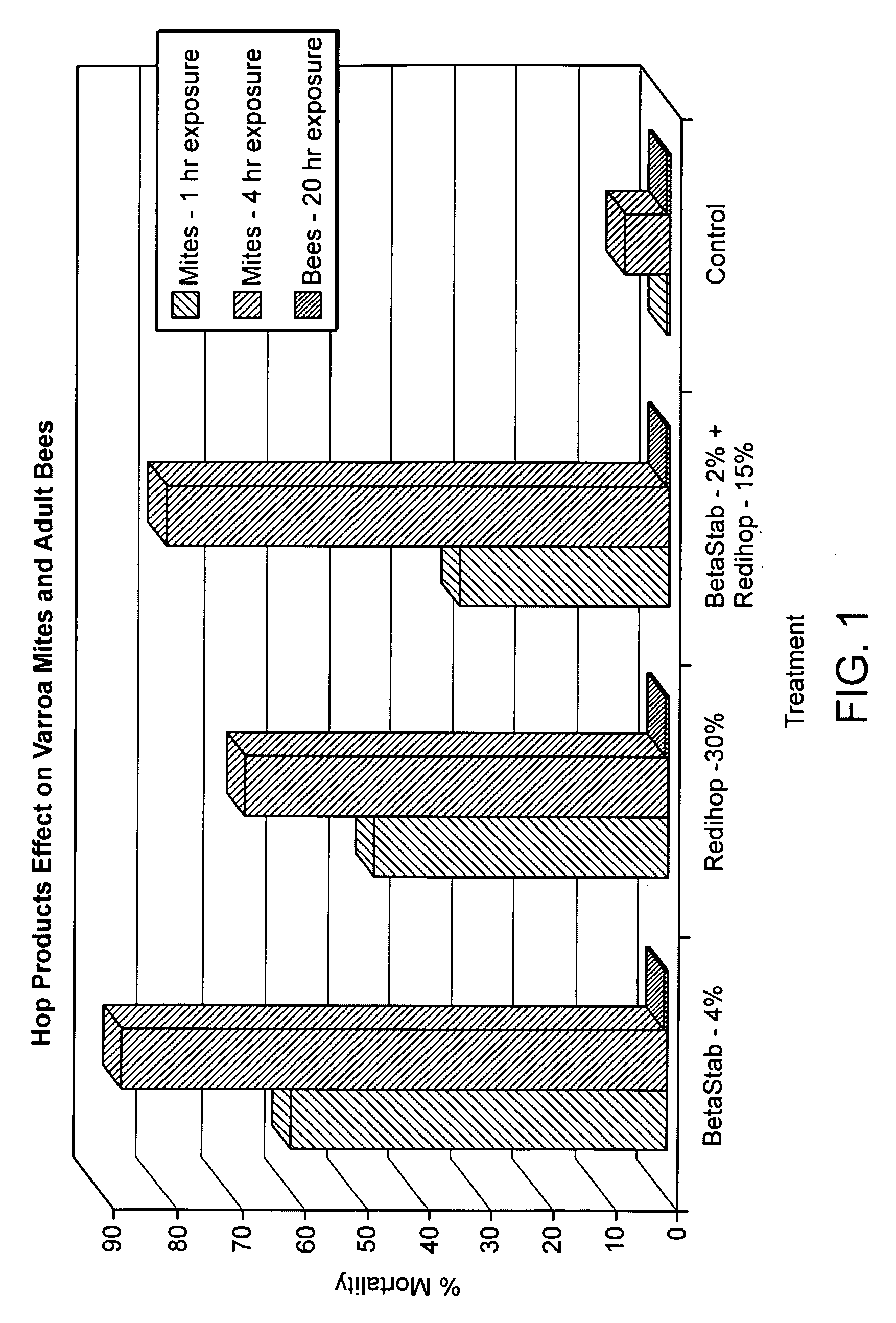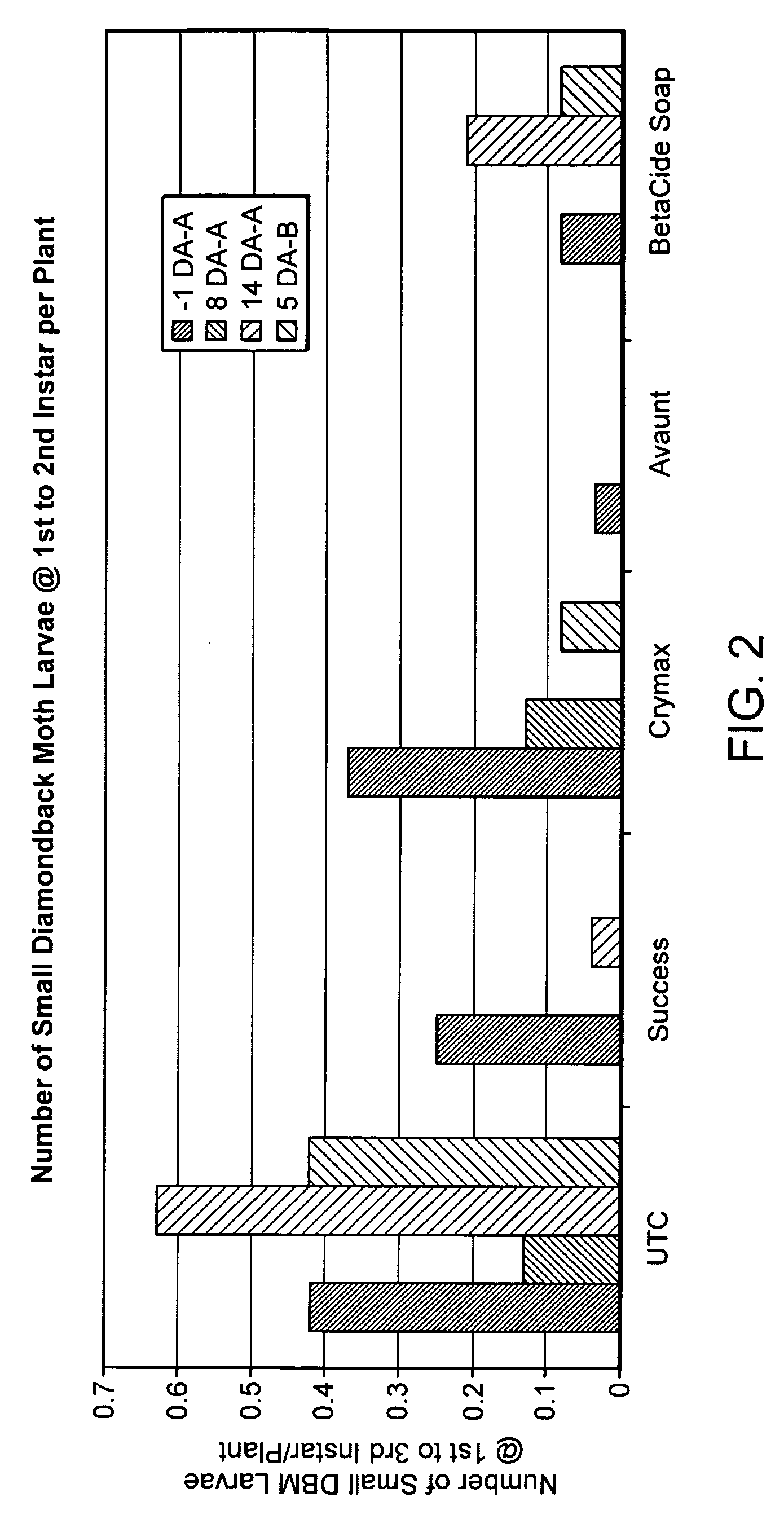Compositions and methods for inhibiting a honey bee pathogen infection or controlling a hive infestation
a honey bee and pathogen technology, applied in the field of compounding and methods for inhibiting a honey bee pathogen infection or controlling a hive infestation, can solve the problems of weakened bee colonies, easy infections, and weakened bee colonies, so as to reduce the success rate, stabilize the growth rate, and reduce the success rate of the mite population
- Summary
- Abstract
- Description
- Claims
- Application Information
AI Technical Summary
Benefits of technology
Problems solved by technology
Method used
Image
Examples
example 1
M. plutonis Assay with Hop Beta and Alpha Acids
[0112]The disk-diffusion method (Kirby-Bauer) is suitable for testing bacterial or fungal isolates for susceptibility to a biocide comprising a hop derivative. In brief, an agar plate suitable for bacterial or fungal growth is uniformly inoculated with a test organism and a paper impregnated with a fixed concentration of a hop derivative is placed on the agar surface. Growth of the organism and diffusion of the antibiotic commence simultaneously resulting in a zone of inhibition in which the amount of biocide exceeds inhibitory concentrations. The diameter of the inhibition zone is a function of the amount of drug in the disk and susceptibility of the microorganism.
[0113]A suspension of Melissococcus plutonis was grown up in MPM media.
Glucose10.0gSoluble starch2.0gPeptone (Oxoid L37)2.5gYeast Extract (Oxoid L21)2.5gNeopeptone, DIFCO (BD 211681)5.0gTrypticase Peptone (BD 211921)2.0g1 M Phosphate buffer, pH 6.750.0mlL-Cysteine•HCl0.25gDis...
example 2
Paenibacillus larvae Assay with Hop Beta and Alpha Acids
[0118]A suspension of Paenibacillus larvae was grown up in Brain Heart Infusion (BHI) broth at 35-37° C. grown under aerobic conditions overnight until turbid then subcultured to BHI agar. The culture plate was incubated for 3 days in the presence of filter paper. The bacterial suspension was streaked over the surface of the BHI agar to obtain uniform growth and the plates were dried. Filter paper discs were treated with Tetrahop Gold® formulation (9% tetrahydroisoalpha acids), Hexahop 95® formulation (5% hexahydroisoalpha acids and 5% tetrahydroisoalpha acids) or Betastab 10A® formulation (10% beta acids), which were diluted as follows:
[0119]BetaStab 10A® 1 ml into 99 ml H20;
[0120]Tetrahop Gold® 1.1 ml into 98.9 ml of H20;
[0121]Hexahop 95 0.5 ml into 99.5 ml sterile water.
[0122]The plates were incubated overnight, and the diameter of the zone of growth inhibition around each disk was measured. The zone of inhibition for each o...
example 3
Hop Beta and Alpha Acids Used in Miticide Screening
[0123]Beta acids, alpha acids, and a combination of beta and alpha acids were screened for efficacy as miticides. Liquid test products containing beta acids were provided in a BetaStab 10A® formulation (10% beta acids) hereinafter called “Betacide”. Liquid test products containing alpha acids were provided in a Redihop® formulation (30% rhoisoalpha acids), Isohop® formulation (30% isoalpha acids), Tetrahop Gold® formulation (9% tetrahydroisoalpha acids), Hexahop Gold® formulation (5% hexahydroisoalpha acids and 5% tetrahydroisoalpha acids). A combination of alpha and beta acids were prepared by mixing equal parts Redihop® and Betacide. Powdered test products containing beta acids were provided by a magnesium salt formulation of beta acids. Powdered test products containing alpha acids were provided by magnesium salt formulations of Redihop®, Tetrahop Gold® and Hexahop Gold®.
[0124]Tests were carried out using the concentrations of be...
PUM
| Property | Measurement | Unit |
|---|---|---|
| size | aaaaa | aaaaa |
| size | aaaaa | aaaaa |
| size | aaaaa | aaaaa |
Abstract
Description
Claims
Application Information
 Login to View More
Login to View More - R&D
- Intellectual Property
- Life Sciences
- Materials
- Tech Scout
- Unparalleled Data Quality
- Higher Quality Content
- 60% Fewer Hallucinations
Browse by: Latest US Patents, China's latest patents, Technical Efficacy Thesaurus, Application Domain, Technology Topic, Popular Technical Reports.
© 2025 PatSnap. All rights reserved.Legal|Privacy policy|Modern Slavery Act Transparency Statement|Sitemap|About US| Contact US: help@patsnap.com



